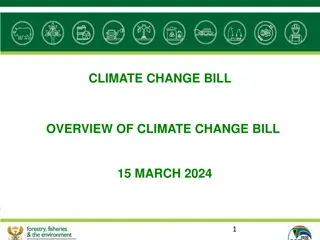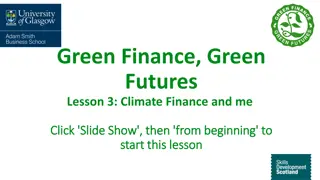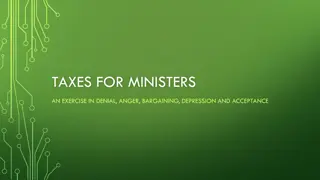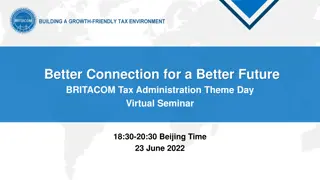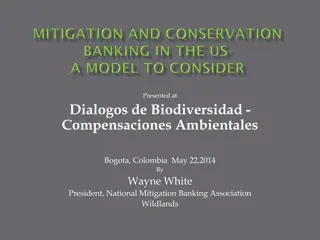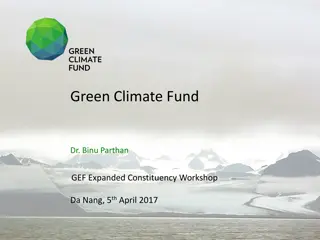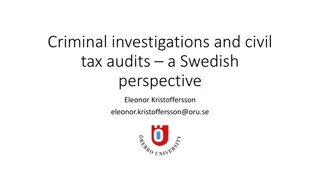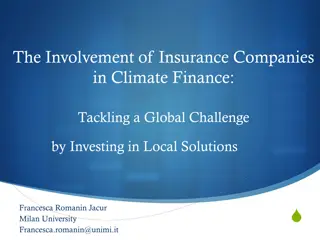The Economics of Green Tax Shift for Climate Change Mitigation
The concept of a Green Tax Shift involves implementing market mechanisms like carbon taxes to reduce greenhouse gas emissions without harming living standards. Economists support this approach, citing its benefits in slowing climate change and improving productivity. The strategy involves focusing on low-hanging fruit solutions, utilizing the emissions reduction multiplier, and prioritizing cost-effective options over expensive renewable energy sources. The consensus emphasizes the use of policy options that balance environmental concerns with economic efficiency.
Download Presentation

Please find below an Image/Link to download the presentation.
The content on the website is provided AS IS for your information and personal use only. It may not be sold, licensed, or shared on other websites without obtaining consent from the author.If you encounter any issues during the download, it is possible that the publisher has removed the file from their server.
You are allowed to download the files provided on this website for personal or commercial use, subject to the condition that they are used lawfully. All files are the property of their respective owners.
The content on the website is provided AS IS for your information and personal use only. It may not be sold, licensed, or shared on other websites without obtaining consent from the author.
E N D
Presentation Transcript
The Green Tax Shift concept and the economics of climate change Source: www.OzPolitic.com
What Im going to talk about Statement of economic consensus Low hanging fruit The emissions reduction multiplier High hanging fruit Perfect competition- the ideal free market Carbon Taxes Green Tax Shift Implications for international negotiations Implications for price stability Bonus material: Other green taxes and economic mechanisms Sources of conflicting economic advice
Statement of economic consensus https://en.wikipedia.org/wiki/Economists%27_Statement_on_Climate_Change Economics studies have found that there are many potential policies to reduce greenhouse-gas emissions for which the total benefits outweigh the total costs. For the United States in particular, sound economic analysis shows that there are policy options that would slow climate change without harming American living standards, and these measures may in fact improve U.S. productivity in the longer run. The United States and other nations can most efficiently implement their climate policies through market mechanisms, such as carbon taxes or the auction of emissions permits. The revenues generated from such policies can effectively be used to reduce the deficit or to lower existing taxes. Signed by more than 2600 economists in 1997
Low hanging fruit When we buy an item, we consider how much we desire it vs how reluctant we are to let go of our hard-earned cash Some people also consider the ecological footprint of the product (but not very well) Light bulbs and apple pies Large number of invisible ways to reduce GHG emissions for a very low price disconnect between what people actually want and GHG emissions. Economics as the hopeful science
The emissions reduction multiplier If you can: Produce electricity with half the GHG emissions Produce a material with half the electricity Produce an item with half as much material Buy half as many items Recycle half the items you buy (assume no significant emissions) You reduce your emissions by 97% with little impact on quality of life.
High hanging fruit Renewable energy sources are very expensive and should not be implemented until we have exhausted cheaper options. Those cheaper options can be done, and the more expensive options may not be necessary. Reducing consumption is generally much cheaper, because no-one actually wants to emit GHG s (or drink petrol, or eat electricity) People want things like light, transport, comfort, entertainment, which can be obtained in a variety of ways. Government cannot make these decisions for us, but are expected to do something (anything but a tax )
Perfect competition the ideal free market Microeconomics: The invisible (God-like) hand of the free market, achieving an ideal outcome through the interaction of supply and demand under certain conditions (assumptions), called perfect competition No (negative) externalities Zero transaction costs Well defined property rights Many buyers and sellers (no monopolies, no-one has the market power to set the price, no economies of scale or network effects, laws against anti-competitive behaviour) Informed consumers and producers Homogenous products (commodities no premium products) No barriers to entry and exit Mobile means of production Profit maximising sellers and rational buyers Justification for government intervention
Carbon Taxes Carbon taxes increase the price of every item for sale according to it s carbon footprint. They are intended to be avoided (by lowering our carbon footprint). Internalises the negative externality, gets rid of the transaction cost, invents a property right (sort of) People inevitably choose the cheapest or least disruptive options for reducing GHG emissions, in a rational timeframe (low hanging fruit). Increase the tax to make more expensive options happen (if necessary).
Green Tax Shift Where does the money go Reducing other taxes. Funding GHG capturing (at the same price) NOT funding renewables Ensures that the real cost of the initial changes society makes to reduce GHG emissions are close to zero. Avoids confounding the GTS with the politics of big vs small government.
Implications for international negotiations Cap and trade creates a literal third currency that (unrealistically/undeservedly) demands trust in foreign governments. They make large transfers of this currency between countries inevitable, as well as payoffs to poorer countries. Carbon taxes achieve the same thing, but keep the money in the country.
Implications for price stability Taxes control the price and let the market determine the quantity traded , whereas trading schemes fix the quantity and let the market determine price. People invest to reduce GHG emissions based on the price of emissions, but do not care what the total emissions are. Taxes provide a steady predictable price (return on investment) whereas cap and trade schemes cause unpredictable fluctuations in price (risky investments)
More information http://www.ozpolitic.com/green-tax- shift/green-tax-shift.html
Other green taxes and economic mechanisms Price of water should reflect marginal cost of supply (dams), the value we place on dam-free rivers, GHG emissions from cement and sediment, and implications for fisheries and scarcity in a drought (watering cans = communism). Price of petrol should reflect cost of supplying it, building and maintaining roads (petrol consumption is a convenient proxy measure of road wear and space consumed), and emissions tax. Price of steak should reflect minimum known net GHG impact of methane emissions from cattle. And GST on top of these taxes. Price of electricity should be variable.
Sources of conflicting economic advice Economists are asked to predict the future Economists (or people pretending to be economists) confuse positive and normative economics. Positive: what is true, what the consequences of government policy will be Normative: what is good, what is fair, what the government should do (regardless of consequence) Economics is often counter-intuitive The road to hell is paved with good intentions Need more economics in school
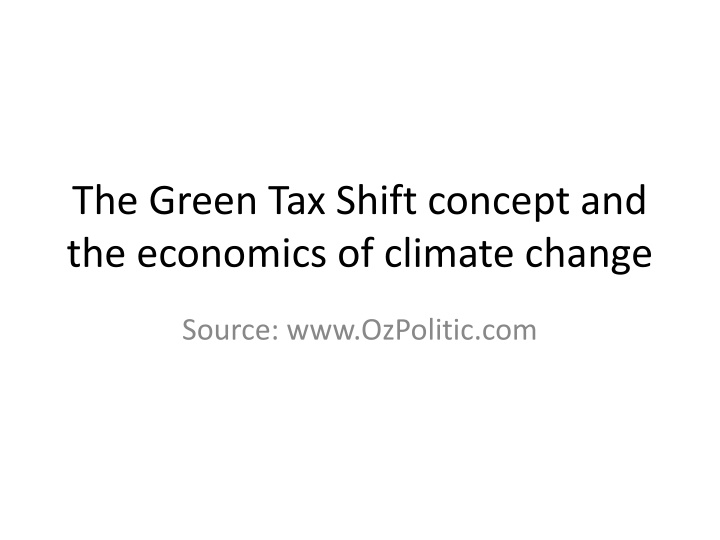



![Town of [Town Name] Real Estate Tax Rates and FY 2024 Budget Summary](/thumb/62211/town-of-town-name-real-estate-tax-rates-and-fy-2024-budget-summary.jpg)


